This was published 9 months ago
The fight to save a hidden Hollywood, only a stone’s throw from Melbourne
Community pride is building in this town bypassed by rockstars and rain.
By Liam Mannix
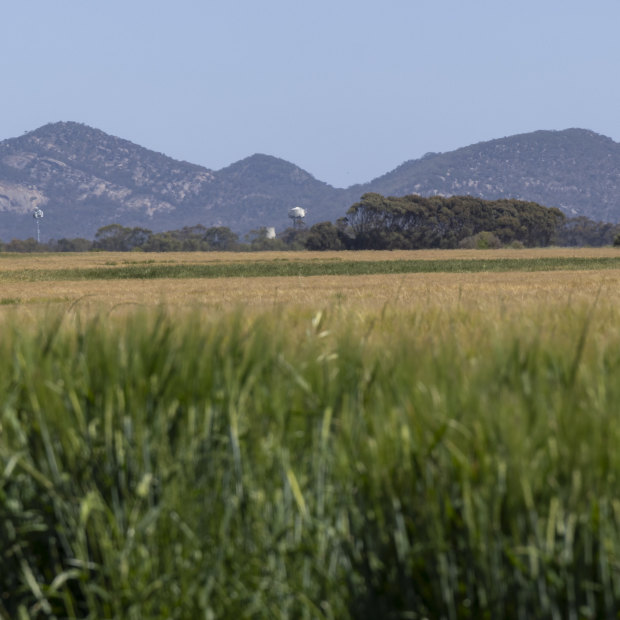
The You Yangs.Credit: Wayne Taylor
The most famous story about Little River isn’t about Little River at all. It picks up on the M1, halfway between Melbourne and Geelong. A van races down the blacktop, its headlights the only illumination. In the back sit four musicians, looking for a sign.
The band is called Mississippi, and they are on the way to play a gig in Geelong. They know that name sucks – you can’t name an Australian rock band after an American river.
And then, providence delivered a sign, right there in the headlights. LITTLE RIVER. “Hey,” says Glenn Shorrock, turning to his bandmates. “What about Little River Band?”
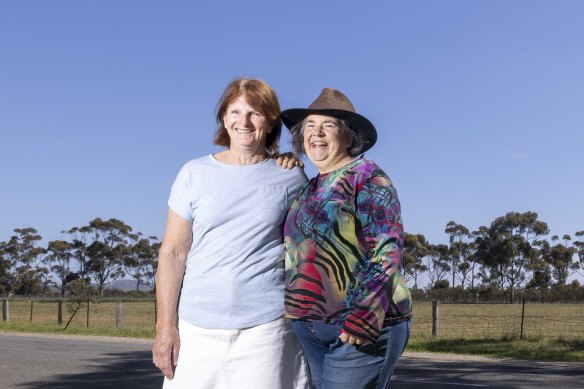
Lyn Wood (left) and Merryn Pike. “People probably drive through and go, ‘There’s nothing here’. Well, that’s what we like about it,” says Wood. Credit: Wayne Taylor
There are general grunts of agreement. And the van speeds off into the night.
So you see, Little River’s most famous namesakes – seller of 30 million records – never even drove through the town.
That’s part of the story of this place: a town bypassed by rock stars and the rain, sewerage, water and gas. A town just minutes from Geelong or Melbourne but also, somehow, in the middle of nowhere.
The locals wouldn’t have it any other way. “People probably drive through and go, ‘There’s nothing here’. Well, that’s what we like about it,” says longtime local Lyn Wood.
But people are starting to discover Little River. Giant companies dream of concreting the town off the map, and real estate agents circle like vultures over a wounded buffalo. The subdivisions of Werribee and Lara creep ever closer. The town’s future is under threat.
“This is a community that’s constantly having to fight to be in love with where they live,” says Getaway host Catriona Rowntree, who has lived there for more than 20 years.
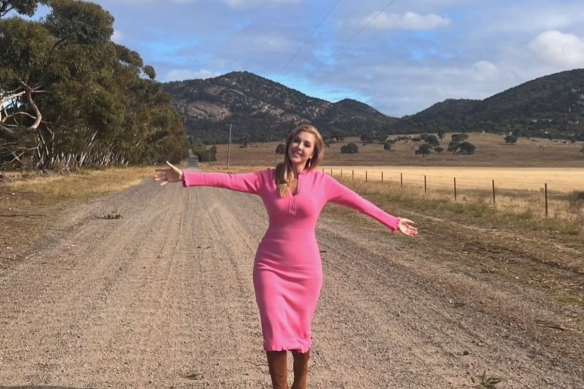
Catriona Rowntree has lived in Little River for more than 20 years.
But fight they are – and Little River might even be winning.
To get to Little River, you take the same route as the band: drive about 40 minutes south-west from Melbourne down the M1 toward Geelong. Then take the off-ramp at the aforementioned road sign, pass the pump station and the blue Pacific National protest signs, and you’re there.
There’s a pub and a few churches, a beautiful white weatherboard mechanics hall, a school. And that’s about it.
“You get off the freeway, go over the bridge, see the You Yangs, and I just go ahhh. Thank god. It’s pretty quiet here,” says Emma Sutcliffe, who bought into the town in 2010.
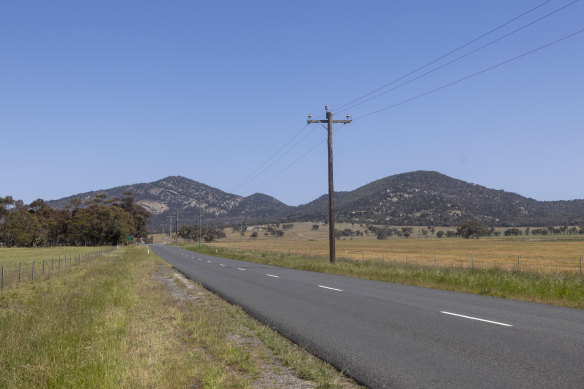
The road into Little River.Credit: Wayne Taylor
The town is bisected by the low, dark waters of Little River. Inexplicably, someone thought it a good idea to draw the council boundaries down the river. So on Geelong Cup Day, the Geelong City Council half of the town gets a public holiday – and the other half does not. And it’s the other way around on Melbourne Cup day, which is a Melbourne-only holiday.
During COVID-19, half of the town was locked down and half wasn’t. Police set up a checkpoint in the middle of town. Locals compared it to Checkpoint Charlie and the Berlin Wall.
The town’s second-biggest landmark is Flinders Peak, at the tip of the You Yangs. Jutting into the sky, it cleanly slices the passing clouds in half like a granite knife, so weather moving in from the west neatly divides and misses the town altogether.

Little River’s general store.Credit: Wayne Taylor
“It’s one of the driest areas in the state,” says Wood. “It’s incredible. It can be pouring in Werribee and pouring in Geelong, and here it’s just sunshine.” Little River does not have an official weather station, so this claim has to remain local legend.
You Yangs comes from Wurdi Youang, or perhaps Ude Youang, words spoken by the local Wathaurong to mean “big mountain in the middle of a plain” - which sums up the place to a tee.
That brings me to the biggest landmark in this dry town: a really, really big boat.
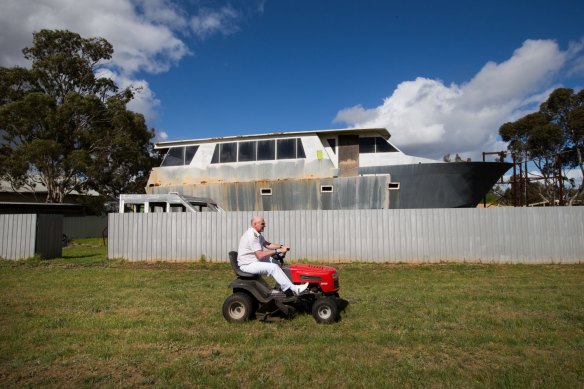
Henry Fries has been building his own boat by hand in his backyard for the past 25 years. One day soon this Little River icon will sail away.Credit: Jason South
It’s 60 feet long, weighs 30 tonnes, has two diesel engines, eight beds, a bar – and has never been in the water. It is moored in Henry Freise’s backyard; he has built it entirely by hand, at a cost of at least $400,000.
Development of the boat has been under way for at least 30 years, and appears to be ongoing. Locals cover their faces with their hands and groan when asked about it.
Freise was not home when your correspondent visited. But when The Age profiled him eight years ago, he talked of sailing her up and down the coast. “Spend five or 10 years on board, a home away from home, crack a beer, motor into some bay or some cove somewhere, kick back, relax,” he said.
But the local rumour is new bridges over the freeway are too low to allow transit of such a huge pleasure craft. “He can’t get the boat off now,” says one resident with a laugh. “He’ll have to take the top off to ever get near the water.” Like the rainfall, we await confirmation.
Little River has always been out of the way. A small inn was built near there in 1839 as a half-way resting house between Melbourne and Geelong – but most travellers took a boat, rather than the stony overland path, and the inn struggled for business. Eleven years after construction, the inn burnt to the ground.
Grander ambitions arrived with the new railway track connecting Geelong and Melbourne, and a grand bluestone train station was erected in 1864. The town enjoyed a small, short-lived boom with new shops, hotels and settlers to farm the land.
Those farms were handed down generation to generation, with some still retained by descendants.
“My generation sort of spoiled that,” says Garry Green, who was born there in 1966. “A lot of my mates saw what their grandparents and parents went through, the heartache and hardships of farming. You’re at the mercy of mother nature and the gods.”
The town once had a mill and a cannery, but both are now long gone. In 1993, the grand train station was shuttered and abandoned.
Little River is perhaps the only bit of true rural townscape between Geelong and Melbourne left, Green reckons.
Much of regional Victoria has trended bourgeois in the past 30 years, as Airbnbs, artist studios and artisan coffee have intruded on small-town life. Not in Little River, where the best coffee is still to be found at the local servo (it is pretty good, to be fair). There’s still no mains gas or sewerage connection, and only half the town is on mains water.
“We get missed by everything. And that’s one of the good things about it,” says Merryn Pike.
But farmers are slowly being replaced by hobby farmers.
“People did a lot more of what you’d call farming back then than you see now,” says Greg Archer, captain of the local CFA brigade.
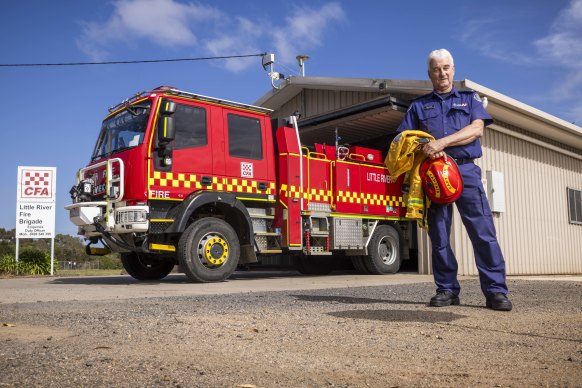
Greg Archer, Little River Fire Chief.Credit: Wayne Taylor
And some people now don’t want to see the earth there exploited at all.
The region’s black volcanic earth is rich and fertile. Before Europeans arrived, a carpet of lavender and magenta wildflowers would have stretched between Melbourne and Adelaide, all grazed by kangaroos and lizards, brolgas, bettongs and bandicoots.
The Wathaurong camped and hunted there. They nourished the ecosystem with regular fire, and it in turn sustained them. “This was the first place in the world that bread was ever made,” says Professor Sarah Bekessy of the Biodiversity Council.
There were enough resources here to sustain the building of monuments: Wurdi Youang, an ancient Indigenous arrangement of stones, is made of about 100 basalt stones lining up with the point on the horizon where the sun sets at equinox and solstice.
Come in the spring and the land around Little River still looks luscious and green. But that’s surface deep: hundreds of years of extraction and fertilisation, and the disruption of the fire regime, have degraded the land. “What we’re seeing is a skeleton of what used to be,” says Bekessy. The natural temperate grassland that once existed there is now critically endangered.
Pike has spent years turning her front and backyards into a native garden. The project is so successful she’s even attracted some extremely endangered growling grass frogs, who sunbathe on rocks around her small pond.
“We’re keen on the environment here. To say, ‘No, you’re not going to ruin the last 1 per cent we’ve got’,” says Pike.
Sutcliffe has a paddock she’s slowly restoring back to its original volcanic grassland state.
“A lot of people live out here specifically because we’ve got this green wedge area. A lot of people around town are starting to re-wild parts of their property. We’re trying to plant some trees, get it back to what it used to look like.”
The state government has even grander plans. It has committed to purchasing 15,000 hectares of private land here to build a vast, protected reserve directly to Little River’s north.
The town could become a gateway to a thriving park reserve home to eagles, koalas and fat-tailed dunnarts – and then on to the You Yangs, already home to the private Mt Rothwell reserve.
An opportunity for film-tourism also feels like it’s going begging. Film-makers have flocked here for decades, drawn by the beautiful pastoral landscape and the historic buildings.
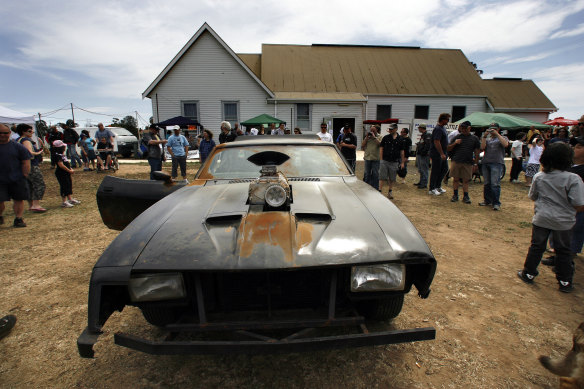
Fans gather in 2008 to celebrate the 30th anniversary of Mad Max being made in Little River.Credit: Angela Wylie
“Ever heard of Mad Max?” says Rowntree. “The Dressmaker. The TV series The Man from Snowy River. Royal Flying Doctor Service. The Pacific with Tom Hanks. The list is endless.”
Rowntree moved into the town in 2000 after falling in love with a local farmer. She’d drive the streets with a sense of deja-vu – it all looked so familiar. Then she started to recognise locations from her favourite films. “This tiny town is absolutely packed with film locations.”
That’s one future. But predators lurk, with their own ambitions.

The Dressmaker, starring Kate Winslet, was largely shot in Little River.
They drive shiny cars into town, and walk up driveways in shiny suits. Always with the same question: are you ready to sell your house yet?
“It’s a constant,” says Rowntree.
Archer says: “Everyone gets the same. It drives you crazy.”
Some locals have even started putting their dogs in their front yards to deter the real estate agents, but still they come. Because they know there’s gold under Little River.
To understand why, we need to return to the 1960s, as a population boom pushed Melbourne’s suburbs out into farmland. Planners decided to funnel development down radial corridors running along transport links, while banning development in other areas – a policy that produced characteristic wedges of green farmland in between development corridors.
As land values across Melbourne have skyrocketed, so has the value of that locked-up land. Developers and investors look at the city’s population growth – we are, once again, in a housing crisis – and suspect the government will surely be forced eventually to open up the wedges to development.
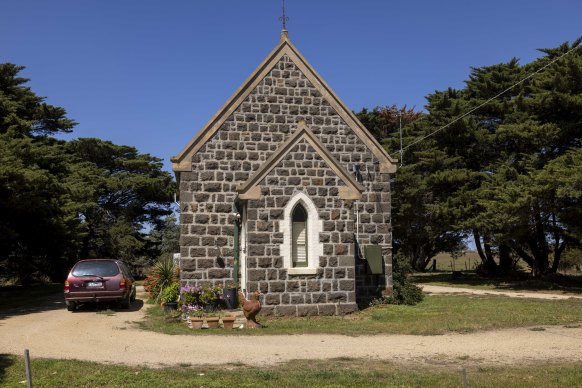
Little River’s bluestone church.Credit: Wayne Taylor
The state government’s large debt burden adds to the pressure. “If they want to make some money through windfall taxes, they’ll have to rezone,” says one real estate agent who we aren’t naming – for obvious reasons.
Investors are making a bet that will happen soon. “It’s a very limited stock, because everyone is holding. So whatever comes up goes quickly,” the agent says. “They leave it. And they wait.”
This leads to subtle changes to the town. More renters. More vacant homes. The community is changing. The town’s also close enough to Melbourne or Geelong that people can easily live here and commute daily to work.
“They virtually just come here for eating or sleeping. They don’t do a lot here,” says Archer. His all-volunteer fire brigade has shrunk from about 50 people to just 29, even as the number of callouts increases.
The encroachment of the suburbs has also brought with it a more urban type of crime. There was a violent home invasion last year. Quiet and just off the highway, it’s also the perfect place for car thieves to dump their stolen wheels, and set fire to them. And some of the cheap rentals have been occupied by “shady” characters, says Archer.
“They do whatever they want there. We turn up at jobs sometimes, there’s a fire, they still don’t want us there.”
But the real estate agents and land-bankers actually turned out to be small-fry.
Last October, The Age revealed plans by Pacific National, the country’s largest freight company, to build a huge $5 billion rail terminal and warehousing hub within Little River.
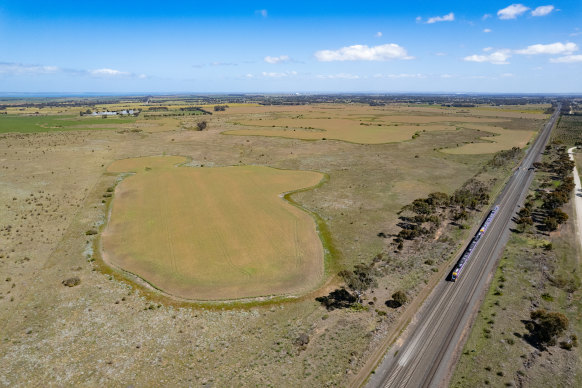
A train travels past the possible site for a freight terminal proposed by Pacific National in Little River.Credit: Jason South
The 350-hectare site would have been just 1.5 kilometres from town. Pacific National hoped to run it 24 hours a day, processing 2 million shipping containers a year.
“How can you let that happen?” says Pike.
The town formed a committee that soon became an Action Group, with Pike as vice president.
Community nights were soon put together at the corner store. Pike got up and spoke about the effect on the environment; others talked about stormwater and chemicals. Afterwards, people came up to talk to her – people she hadn’t met before. An ecologist, a chemical expert, a doctor, the CEO of a billboard company.
They covered the town in posters and put up a huge billboard. They asked pointed questions about Pacific National’s environmental surveys, and conducted their own.
“Pacific National were utter shits throughout the whole process,” says Sutcliffe. “You can print that.”
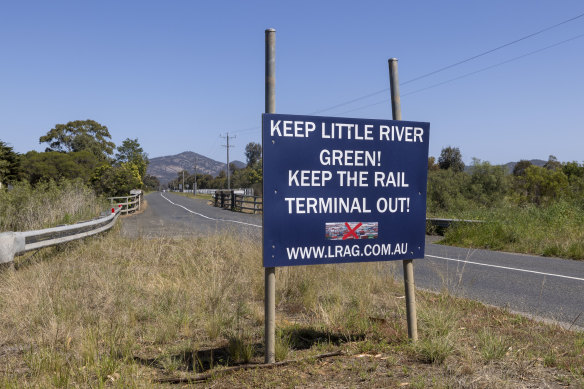
A protest sign stands at the entrance to the town.Credit: Wayne Taylor
They held public rallies. They got council and politicians onside. A community that was starting to fray was suddenly galvanised by a common enemy.
When Pacific National pulled the project last month – citing “broader economic factors”, a claim no one in town believes – they held a party at the town park. Everyone was there, adults and kids, riding around the streets on bikes, being part of something together.
It was just like the old days, like how the town used to be. “It’s actually come back a bit, because of PN,” says Archer. “In some ways, it’s done us a bit of a favour.”
Pike says: “We managed to do the David and Goliath story. We’re a town that won.”
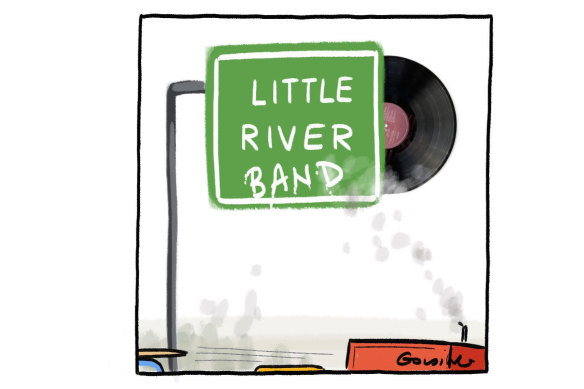
Credit: Matt Golding
And winning has changed how they feel about their little town.
“Now I’ve gone through this process, I appreciate it so much more,” says Wood.
“We toyed with moving. A lot of our friends have done that. But it’s kind of cemented how I feel.”
The committee has voted to remain incorporated, and work to defend and even grow the town.
Funding is going into turning the shuttered train station into a community hall. There’s even word of pushing the government to buy up the area Pacific National wanted to develop to turn it into a wildlife corridor.
They are going to fight to protect what they love, rather than let it be taken bit by bit away from them.
“It is possible for small towns to unite. And it is possible for us to win,” says Pike.
“People say you can’t fight progress, but I think you can.”
Start the day with a summary of the day’s most important and interesting stories, analysis and insights. Sign up for our Morning Edition newsletter.